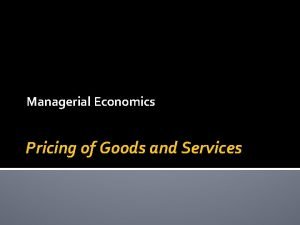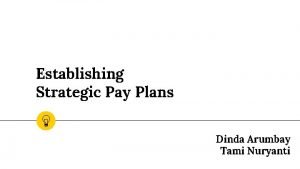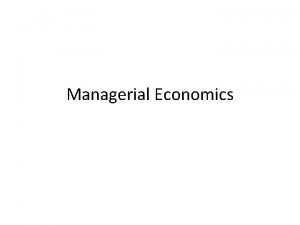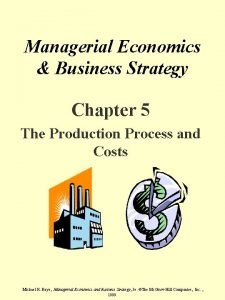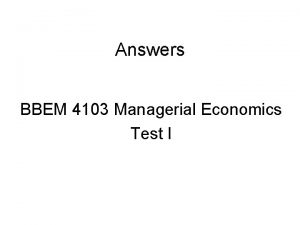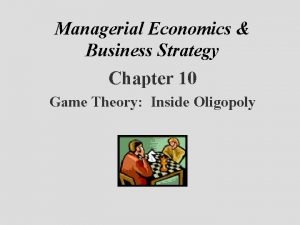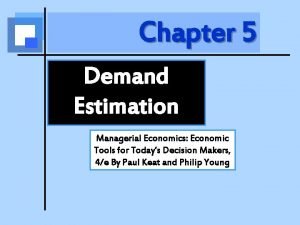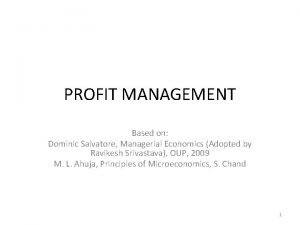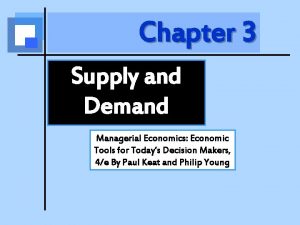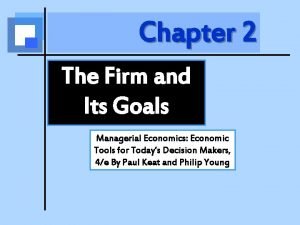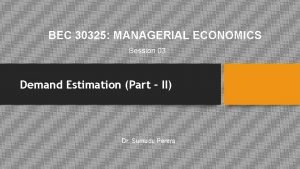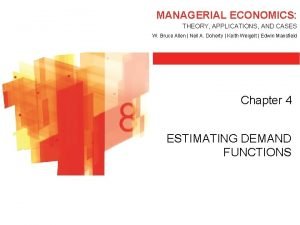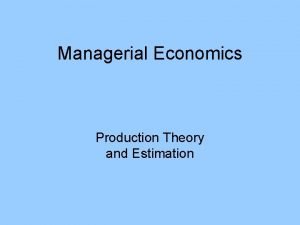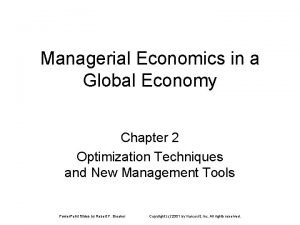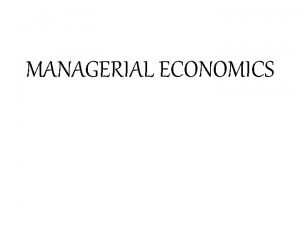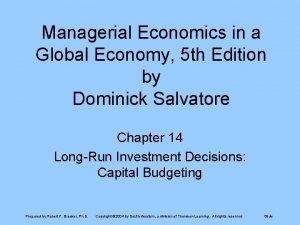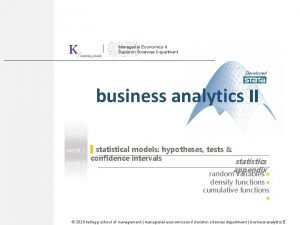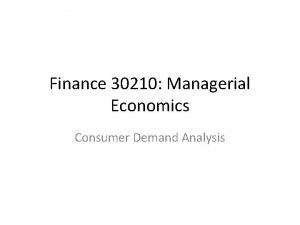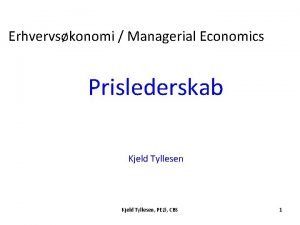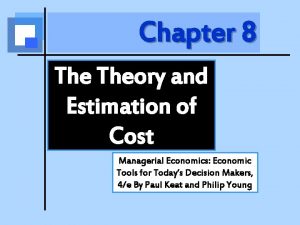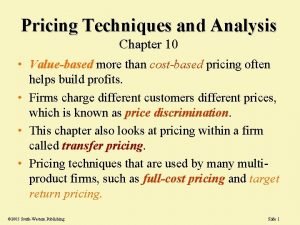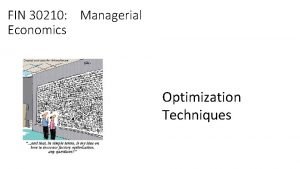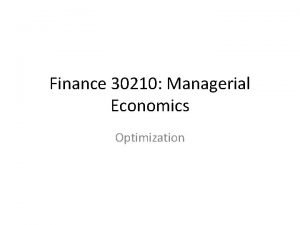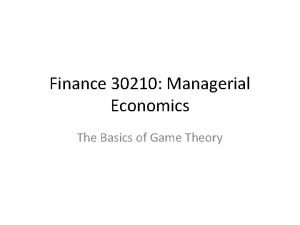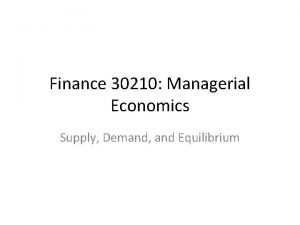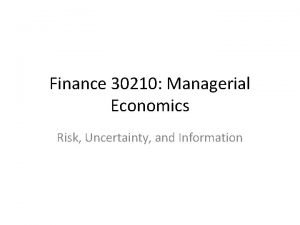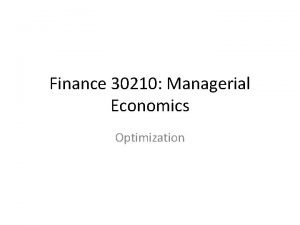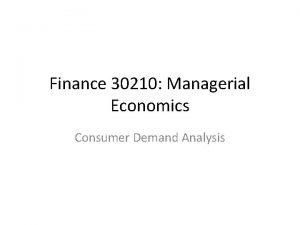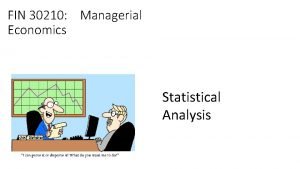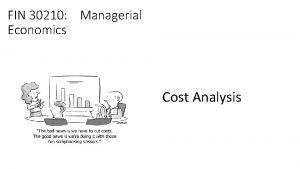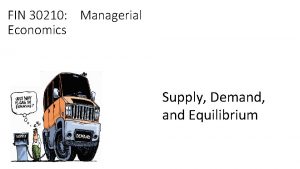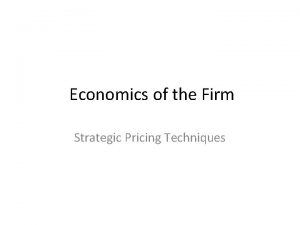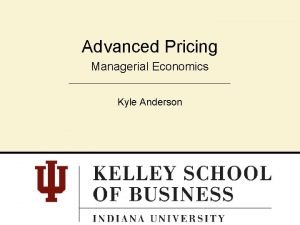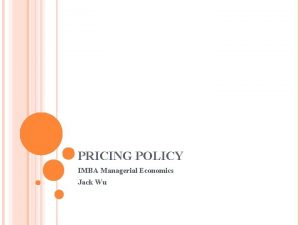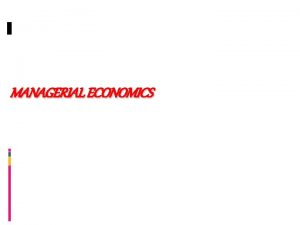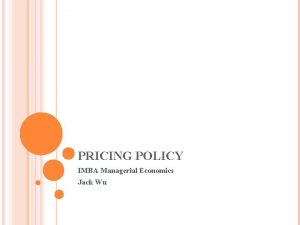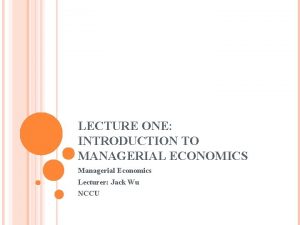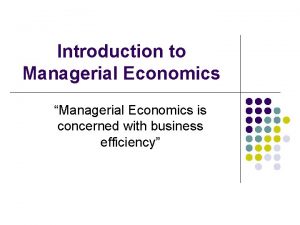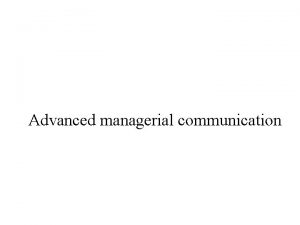Finance 30210 Managerial Economics Strategic Pricing Techniques Recall



















































- Slides: 51

Finance 30210: Managerial Economics Strategic Pricing Techniques

Recall that there is an entire spectrum of market structures Market Structures Perfect Competition Monopoly üMany firms, each with zero üOne firm, with 100% üP = MC üProfits = 0 (Firm’s earn a üP > MC üProfits > 0 (Firm’s earn üNO STRATEGIC market share reasonable rate of return on invested capital) INTERACTION! market share excessive rates of return on invested capital) INTERACTION!

Most industries, however, don’t fit the assumptions of either perfect competition or monopoly. We call these industries oligopolies Oligopoly üRelatively few firms, each with positive market share üSTRATEGIES MATTER!!! Wireless (2002) US Beer (2001) Music Recording (2001) Verizon: 30% Cingular: 22% AT&T: 20% Sprint PCS: 14% Nextel: 10% Voicestream: 6% Anheuser-Busch: 49% Miller: 20% Coors: 11% Pabst: 4% Heineken: 3% Universal/Polygram: 23% Sony: 15% EMI: 13% Warner: 12% BMG: 8%

Market shares are not constant over time in these industries! Airlines (1992) Airlines (2002) American United Delta Northwest Continental US Air SWest While the absolute ordering didn’t change, all the airlines lost market share to Southwest.

Another trend is consolidation Retail Gasoline (1992) Retail Gasoline (2001) Shell Chevron Exxon/Mobil Texaco Exxon Amoco BP/Amoco/Arco Mobil BP Citgo Marathon Sun Phillips Shell Chev/Texaco Total/Fina/Elf Conoco/Phillips

The key difference in oligopoly markets is that price/sales decisions can’t be made independently of your competitor’s decisions Monopoly Oligopoly Your Price (-) Your N Competitors Prices (+) Oligopoly markets rely crucially on the interactions between firms which is why we need game theory to analyze them!

Continuous Choice Games Consider the following example. We have two competing firms in the marketplace. ØThese two firms are selling identical products. Ø Each firm has constant marginal costs of production. What are these firms using as their strategic choice variable? Price or quantity? Are these firms making their decisions simultaneously or is there a sequence to the decisions?

Cournot Competition: Quantity is the strategic choice variable There are two firms in an industry – both facing an aggregate (inverse) demand curve given by D Total Industry Production Both firms have constant marginal costs equal to $20

From firm one’s perspective, the demand curve is given by Treated as a constant by Firm One Solving Firm One’s Profit Maximization…

In Game Theory Lingo, this is Firm One’s Best Response Function To Firm 2 If firm 2 drops out, firm one is a monopolist! 0

What could firm 2 do to make firm 1 drop out?

Firm 2 chooses a production target of 3 3 1 Firm 1 responds with a production target of 1

The game is symmetric with respect to Firm two… Firm 2 responds with a production target of 2 Firm 1 chooses a production target of 1

Eventually, these two firms converge on production levels such that neither firm has an incentive to change Firm 1 We would call this the Nash equilibrium for this model Firm 2

Recall we started with the demand curve and marginal costs

The markup formula works for each firm

Had this market been serviced instead by a monopoly,

Had this market been instead perfectly competitive,

Monopoly 2 Firms Perfect Competition

Recall, we had an aggregate demand a constant marginal cost of production. CS = (. 5)(120 – 70)(2. 5) = $62. 5 Monopoly $120 $70 $62. 5 D What would it be worth to consumers to add another firm to the industry? 2. 5

Recall, we had an aggregate demand a constant marginal cost of production. CS = (. 5)(120 – 53)(3. 33) = $112 Two Firms $53 $112 D 3. 33

Suppose we increase the number of firms…say, to 3 Demand facing firm 1 is given by (MC = 20) The strategies look very similar!

With three firms in the market… Three Firms CS = (. 5)(120 – 45)(3. 75) = $140 $45 D 3. 75

Expanding the number of firms in an oligopoly – Cournot Competition N = Number of firms Note that as the number of firms increases: üOutput approaches the perfectly competitive level of production üPrice approaches marginal cost.

Increasing Competition

Increasing Competition

The previous analysis was with identical firms. Suppose Firm 2’s marginal costs increase to $30 Firm 1 50% Firm 2 50%

Suppose Firm 2’s marginal costs increase to $30 If Firm one’s production is unchanged Firm 2

Firm 1 Firm 2 42% Firm 2’s market share drops 58% Firm 1’s Market Share increases

The previous analysis (Cournot Competition) considered quantity as the strategic variable. Bertrand competition uses price as the strategic variable. Should it matter? P* D Q* Industry Output Just as before, we have an industry demand curve and two competing duopolies – both with marginal cost equal to $20.

Firm level demand curves look very different when we change strategic variables Bertrand Case Quantity Strategy If you are underpriced, you lose the whole market At equal prices, you split the market D D If you are the low price you capture the whole market

Price competition creates a discontinuity in each firm’s demand curve – this, in turn creates a discontinuity in profits As in the cournot case, we need to find firm one’s best response profit maximizing response) to every possible price set by firm 2. (i. e.

Firm One’s Best Response Function Case #1: Firm 2 sets a price above the pure monopoly price: Case #2: Firm 2 sets a price between the monopoly price and marginal cost Case #3: Firm 2 sets a price below marginal cost Case #4: Firm 2 sets a price equal to marginal cost What’s the Nash equilibrium of this game?

Monopoly 2 Firms Perfect Competition However, the Bertrand equilibrium makes some very restricting assumptions… ØFirms are producing identical products (i. e. perfect substitutes) ØFirms are not capacity constrained

An example…capacity constraints Consider two theatres located side by side. Each theatre’s marginal cost is constant at $10. Both face an aggregate demand for movies equal to Each theatre has the capacity to handle 2, 000 customers per day. What will the equilibrium be in this case?

If both firms set a price equal to $10 (Marginal cost), then market demand is 5, 400 (well above total capacity = 2, 000) Note: The Bertrand Equilibrium (P = MC) relies on each firm having the ability to make a credible threat: “If you set a price above marginal cost, I will undercut you and steal all your customers!” At a price of $33, market demand is 4, 000 and both firms operate at capacity

With competition in price, the key is to create product variety somehow! Suppose that we have two firms. Again, marginal costs are $20. The two firms produce imperfect substitutes. Example: D

Recall Firm 1 has a marginal cost of $20 Each firm needs to choose price to maximize profits conditional on the other firm’s choice of price. Firm 1 profit maximizes by choice of price Firm 2 sets a price of $50 Firm 1’s strategy D $30 Firm 1 responds with $55

With equal costs, both firms set the same price and split the market evenly Firm 1 Firm 2

Monopoly 2 Firms Perfect Competition

Suppose that Firm two‘s costs increase. What happens in each case? Bertrand Firm 2 $30 With higher marginal costs, firm 2’s profit margins shrink. To bring profit margins back up, firm two raises its price

Suppose that Firm two‘s costs increase. What happens in each case? With higher marginal costs, firm 2’s profit margins shrink. To bring profit margins back up, firm two raises its price Firm 1 Firm 2 A higher price from firm two sends customers to firm 1. This allows firm 1 to raise price as well and maintain market share!

Cournot (Quantity Competition): Competition is for market share ØFirm One responds to firm 2’s cost increases by expanding production and increasing market share ØBest response strategies are strategic substitutes Bertrand (Price Competition): Competition is for profit margin ØFirm One responds to firm 2’s cost increases by increasing price and maintaining market share ØBest response strategies are strategic complements Bertrand Cournot Firm 1 Firm 2

Stackelberg leadership In the previous example, firms made price/quantity decisions simultaneously. Suppose we relax that and allow one firm to choose first. Both firms have a marginal cost equal to $20 Firm 1 chooses its output first Firm 2 chooses its output second Market Price is determined

Firm 2 has observed Firm 1’s output decision and faces the residual demand curve:

Knowing Firm 2’s response, Firm 1 can now maximize its profits: Firm 1 produces the monopoly output!

Monopoly 2 Firms Perfect Competition (67%) (33%)

Sequential Bertrand Competition We could also sequence events using price competition. Both firms have a marginal cost equal to $20 Firm 2 chooses its price first Firm 2 chooses its price second Market sales are determined

Recall Firm 1 has a marginal cost of $20 From earlier, we know the strategy of firm 2. Plug this into firm one’s profits… Now we can maximize profits with respect to firm one’s price.

Sequential Bertrand Competition Monopoly 2 Firms Perfect Competition

Cournot vs. Bertrand: Stackelberg Games Cournot (Quantity Competition): Ø Firm One has a first mover advantage – it gains market share and earns higher profits. Firm B loses market share and earns lower profits Ø Total industry output increases (price decreases) Bertrand (Price Competition): ØFirm Two has a second mover advantage – it charges a lower price (relative to firm one), gains market share and increases profits. ØOverall, production drops, prices rise, and both firms increase profits.
 Transfer pricing in managerial economics
Transfer pricing in managerial economics Transfer pricing in managerial economics
Transfer pricing in managerial economics Market competitive pay plan adalah
Market competitive pay plan adalah What is managerial finance function
What is managerial finance function The role and environment of managerial finance
The role and environment of managerial finance Managerial finance function
Managerial finance function Meaning of managerial economics
Meaning of managerial economics Two basic components of incremental reasoning are
Two basic components of incremental reasoning are Managerial economics
Managerial economics Demand estimation
Demand estimation Nature and scope of managerial economics
Nature and scope of managerial economics Managerial economics chapter 5
Managerial economics chapter 5 Meaning of managerial economics
Meaning of managerial economics Methods of cost estimation in managerial economics
Methods of cost estimation in managerial economics Basic concepts in managerial economics
Basic concepts in managerial economics Managerial economics questions and answers
Managerial economics questions and answers Game theory managerial economics
Game theory managerial economics Managerial economics 12th edition mark hirschey
Managerial economics 12th edition mark hirschey Opportunity cost principle
Opportunity cost principle Nature and scope of managerial economics
Nature and scope of managerial economics How managerial economics is useful to engineers
How managerial economics is useful to engineers What is demand estimation in managerial economics
What is demand estimation in managerial economics Dominic salvatore
Dominic salvatore Example of managerial economics
Example of managerial economics Supply analysis in managerial economics
Supply analysis in managerial economics Goal of a firm
Goal of a firm Demand estimation in managerial economics
Demand estimation in managerial economics Managerial economics: theory, applications, and cases
Managerial economics: theory, applications, and cases Managerial economics applications strategy and tactics
Managerial economics applications strategy and tactics Calculate certainty equivalent
Calculate certainty equivalent Fundamentals of managerial economics
Fundamentals of managerial economics Production theory and estimation
Production theory and estimation Managerial economics
Managerial economics Managerial economics is called as
Managerial economics is called as Managerial economics
Managerial economics Managerial economics
Managerial economics Managerial economics
Managerial economics Managerial economics in a global economy
Managerial economics in a global economy Managerial economics and decision sciences
Managerial economics and decision sciences Managerial economics demand analysis
Managerial economics demand analysis Prislederskab modellen
Prislederskab modellen Estimation of cost function in managerial economics
Estimation of cost function in managerial economics The strategic pricing pyramid
The strategic pricing pyramid Pricing techniques
Pricing techniques Retail pricing management
Retail pricing management International business finance and economics
International business finance and economics Event studies in economics and finance
Event studies in economics and finance Difference between finance and economics
Difference between finance and economics Event studies in economics and finance
Event studies in economics and finance Central university of finance and economics
Central university of finance and economics Charles university master of economics and finance
Charles university master of economics and finance School of business and economics maastricht
School of business and economics maastricht
